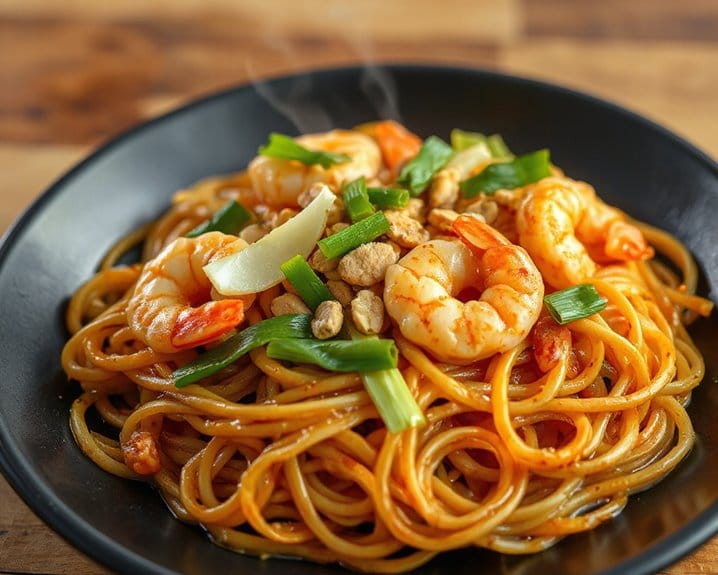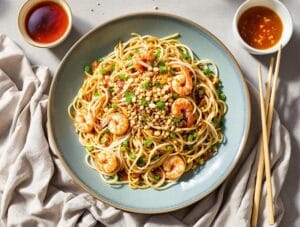Why You’ll Love these Authentic Thai Noodles
If you’ve been searching for a taste of Thailand that won’t leave you feeling like you need a culinary degree, these authentic Thai noodles are about to become your new obsession. The combination of chewy rice noodles, succulent shrimp, and that perfect balance of sweet, sour, and spicy flavors creates something truly magical in just minutes.
The rice vinegar and fish sauce provide that unmistakable Thai tang, while the chili-garlic sauce lets you control just how much heat you can handle. And those crunchy peanuts on top? Heaven. Plus, it’s actually healthier than takeout—brown rice noodles add fiber while keeping all the traditional texture you crave. Restaurant quality, without the wait or the guilt.
What Ingredients are in Authentic Thai Noodles?
Authentic Thai noodles are a delightful blend of sweet, sour, salty, and spicy flavors that create that perfect balance we all crave in Thai cuisine. Pad Thai is perhaps the most recognizable of all Thai noodle dishes, and making it at home isn’t nearly as intimidating as you might think. With just a handful of ingredients, many of which you might already have in your pantry, you can create this restaurant favorite right in your own kitchen.
- 4 ounces wide rice noodles (preferably brown-rice noodles)
- 2 teaspoons peanut oil
- 3 garlic cloves, minced
- 1 large egg, lightly beaten
- 8 ounces small shrimp, peeled and deveined
- 2 cups mung bean sprouts
- 1/2 cup sliced scallion tops
- 3 tablespoons rice vinegar
- 2 tablespoons fish sauce
- 2 tablespoons sugar
- 1 teaspoon chili-garlic sauce
- 2 tablespoons chopped dry roasted peanuts
When shopping for these ingredients, the fish sauce and rice noodles are absolute must-haves for authenticity—no substitutions here, folks. You might be tempted to skip the bean sprouts, but they add a wonderful crunch that balances the soft noodles. And while the recipe calls for shrimp, you could substitute chicken or tofu if seafood isn’t your thing. The roasted peanuts aren’t just a garnish; they contribute essential texture and flavor to the finished dish. Consider adding a squeeze of fresh lime juice at the end for that bright, citrusy finish that makes Thai food so irresistible.
How to Make these Authentic Thai Noodles

Start by preparing your 4 ounces of wide rice noodles—brown rice noodles are preferred for a healthier twist. Simply place them in a large bowl, cover with warm water, and let them soak for about 20 minutes until they become limp and pliable. This soaking method is gentler than boiling and helps maintain the perfect texture for our Pad Thai.
While the noodles are soaking, heat 2 teaspoons of peanut oil in a wok over high heat until it’s nice and hot. Add 3 minced garlic cloves and stir-fry for about 10 seconds until golden and fragrant (your kitchen will smell amazing at this point).
Next, pour in 1 large beaten egg and scramble it quickly for about 30 seconds. Now for the protein—add 8 ounces of peeled and deveined shrimp, stir-frying until they curl and turn a lovely pink color, which should take around 2 minutes.
Drain those soaked noodles and toss them into the wok, using tongs to mix everything until the noodles soften and curl, about a minute or so. For best results, consider using high-end Thai appliances that provide consistent heat distribution for perfect stir-frying. Finally, add 2 cups of mung bean sprouts, 1/2 cup of sliced scallion tops, 3 tablespoons of rice vinegar, 2 tablespoons each of fish sauce and sugar, and 1 teaspoon of chili-garlic sauce. Keep tossing until the shrimp are fully cooked through and the noodles are heated.
For the perfect finishing touch, sprinkle 2 tablespoons of chopped dry roasted peanuts on top before serving for that authentic crunch and nutty flavor.
Authentic Thai Noodles Substitutions and Variations
Looking for ways to customize this classic Thai dish to suit your dietary needs or pantry contents? I’ve got you covered with some easy swaps that won’t compromise that authentic flavor.
For a vegetarian version, replace shrimp with firm tofu or mushrooms. Can’t find rice noodles? Soba or even spaghetti will work in a pinch, though the texture will differ. No fish sauce? Try soy sauce with a splash of lime juice to mimic that umami punch. Peanut allergies? Substitute roasted sunflower seeds or cashews for similar crunch.
Want it spicier? Add more chili-garlic sauce or fresh Thai chilies. For a lighter version, reduce the sugar to one tablespoon and bulk up the bean sprouts. Remember, the best Thai food balances sweet, salty, sour, and spicy perfectly.
What to Serve with Authentic Thai Noodles
Now that you’ve mastered the main dish, let’s talk about perfect companions for your Thai noodles. I always recommend a fresh cucumber salad with rice vinegar dressing—its cool crispness balances the warm, savory pad thai beautifully. Can you imagine a better contrast?
For drinks, Thai iced tea or a light lager works wonders to tame the heat. Don’t forget about appetizers—spring rolls or chicken satay with peanut sauce complement without overwhelming your star dish.
Want to round out the meal? Try serving coconut sticky rice with mango for dessert. The sweet coconut flavor provides the perfect finale after those tangy, umami noodles.
Final Thoughts
Passion for authentic Thai cooking runs deep in this recipe. The simple combination of rice noodles, fresh shrimp, crunchy bean sprouts, and that perfect balance of sweet, sour, and savory flavors creates something truly magical in your kitchen. I’m convinced that mastering Pad Thai at home gives you a superpower—the ability to transport yourself to the bustling streets of Bangkok without a plane ticket.
Don’t worry if your first attempt isn’t perfect. Thai cooking is about finding harmony in contrasting flavors, and that takes practice. Keep adjusting the fish sauce, vinegar, and sugar until you find your perfect balance. Remember, the best part of cooking isn’t just the eating—it’s the journey of creating something authentic with your own hands.

